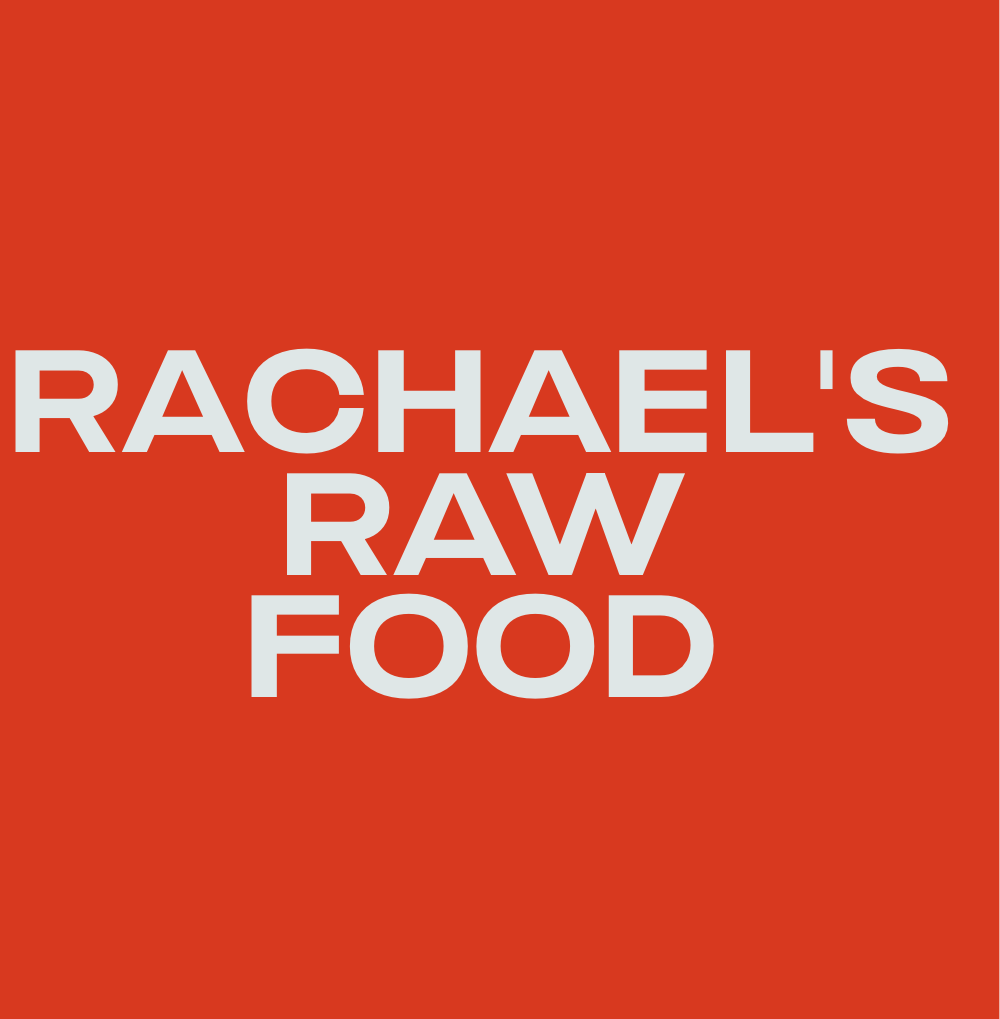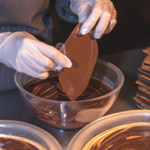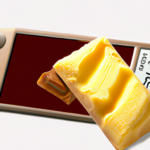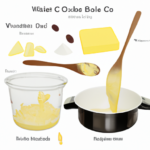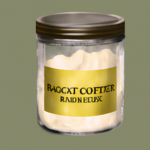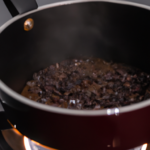Raw Food Ingredients
Prevent Chocolate Melting Woes With These 10 Tricks
Just when you thought keeping chocolate from melting was impossible, discover these 10 expert tricks to save your sweet treats!

To prevent chocolate from melting, store it in a cool, dark place between 50-66.2°F to maintain its shape and texture. Opt for chocolate with a high cocoa content as it helps it remain solid in warm conditions, making it a great choice for desserts that need to hold their form. Avoid exposing chocolate to sunlight as it can accelerate melting, leading to texture loss. Proper wrapping techniques, quick chilling methods, and maintaining the ideal storage temperature are crucial in preserving chocolate. Be mindful of handling chocolate carefully and avoiding overheating during preparation. By following these tips, you can keep your chocolate intact and delicious.
Key Takeaways
- Store chocolate in a cool, dark place to prevent melting and maintain quality.
- Use high cocoa content chocolate for better heat stability and shape retention.
- Avoid sunlight exposure to prevent quick melting and preserve chocolate's structure.
- Properly wrap chocolate to prevent air and moisture affecting texture.
- Utilize insulated containers for transportation to shield against external heat and preserve quality.
Store Chocolate in Cool Place
To prevent chocolate from melting, I always store it in a dark, cool space between 50-66.2°F. This vital temperature range helps maintain the cocoa butter content in the chocolate, ensuring it stays solid and retains its delicious texture. By keeping chocolate in a cool and dry environment, you're safeguarding it against heat damage and preserving its quality for longer periods.
Storing chocolate in temperatures outside the recommended range can lead to undesirable consequences. If it gets too warm, the cocoa butter might start to melt, causing the chocolate to become soft and lose its shape. On the other hand, extreme cold can also affect the chocolate, causing it to develop a whitish coating due to fat streaks. It's important to pay attention to the storage conditions to enjoy your chocolate treats at their best.
Use High Cocoa Content Chocolate
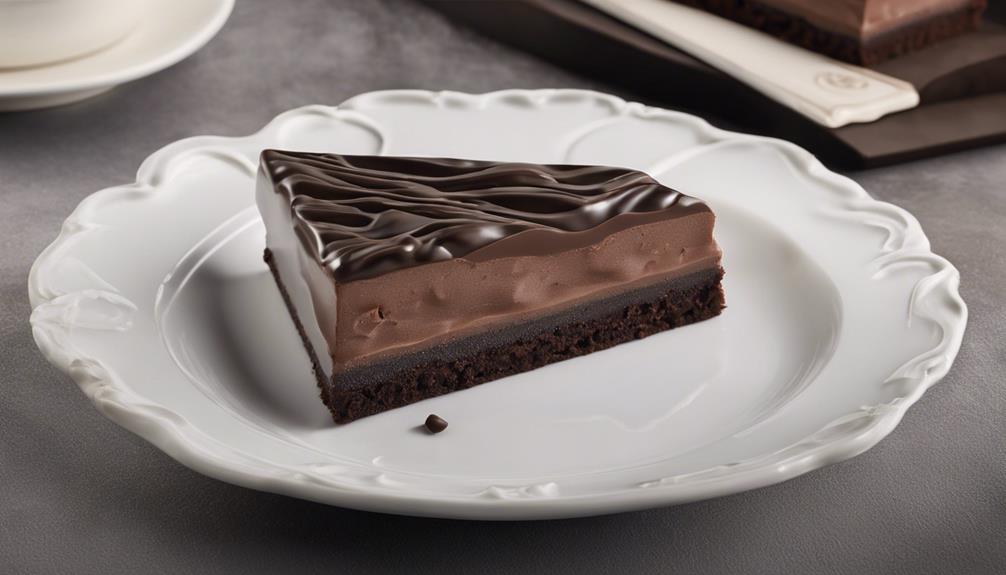
I prefer using high cocoa content chocolate for its superior heat resistance and ability to maintain its shape in warm conditions. High cocoa content chocolate, typically containing at least 70% cocoa, has a higher cocoa butter content, which helps it hold its shape better when exposed to heat. This type of chocolate has a higher melting point, making it less prone to melting even in warm temperatures. Dark chocolate with high cocoa content is especially ideal for hot climates as it stays solid at higher temperatures compared to lower cocoa content chocolates. When making desserts that need to hold their shape in warm conditions, opting for high cocoa content chocolate is a smart choice. Here is a table to highlight the benefits of using high cocoa content chocolate:
| Benefits of High Cocoa Content Chocolate |
|---|
| More stable in heat |
| Higher melting point |
| Maintains shape in warm conditions |
Avoid Direct Sunlight Exposure
Preserving chocolate from direct sunlight is vital to prevent it from melting quickly and maintaining its quality. Direct sunlight can increase the chocolate's temperature, pushing it past its melting point and causing it to lose its shape and texture.
The heat from the sun can alter the taste of the chocolate, making it less enjoyable. Additionally, UV rays in sunlight can speed up the melting process, especially in warmer environments, leading to a messy and unappealing outcome.
To avoid these issues, it's essential to store chocolate in a cool, dark place away from direct sunlight. By doing so, you protect the chocolate's structure and overall quality, ensuring a better experience when you indulge.
Optimal Storage Temperature
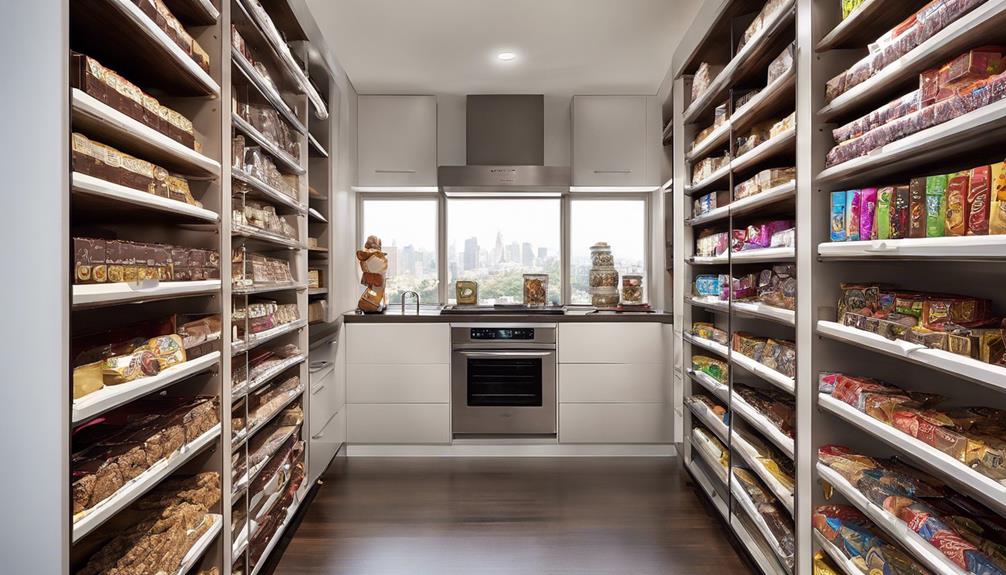
Maintaining chocolate at an ideal storage temperature between 50-66.2°F is important to prevent melting and preserve its quality. Temperatures outside this range can cause issues, like chocolate becoming too soft or its structure being altered. It's best to avoid storing chocolate in the fridge or freezer, as this can lead to unwanted texture changes. Additionally, keeping the storage area dry is essential to prevent bacteria growth and fat streaks in the chocolate.
To guarantee the freshness and quality of products containing chocolate, it's vital to follow specific storage guidelines outlined in recipes. By adhering to these recommendations, you can enjoy your chocolate treats at their best. Remember, the key is to maintain a stable and moderate temperature to prevent melting and preserve the delightful taste and texture of your favorite chocolates.
Properly Wrap Chocolate
When wrapping chocolate, make sure it's tightly sealed using aluminum foil, plastic wrap, or parchment paper to protect it from heat and maintain its shape.
- Keep it Secure: Wrap the chocolate bar snugly to prevent air and moisture from affecting its texture.
- Store Your Chocolate Right: Place the wrapped chocolate in a cool, dark place away from direct sunlight.
- Preserve the Crystal Structure: Proper wrapping helps maintain the chocolate's crystal structure, preventing it from melting easily.
- Maintain Flavor Integrity: By sealing it tightly, you keep unwanted odors at bay, preserving the chocolate's delicious taste.
Utilize Insulated Containers
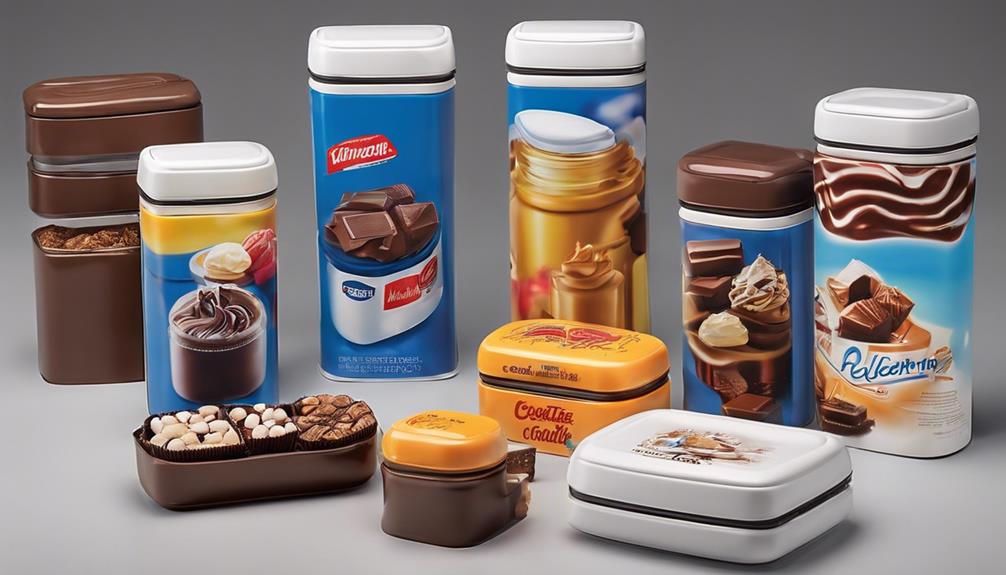
To safeguard chocolate from melting, using insulated containers proves effective in maintaining its temperature during transportation. These containers act as a shield against external heat, keeping your chocolates cool and intact.
Whether you're facing hot weather or starting on a long journey, insulated containers offer a practical solution to prevent melting and preserve the quality of your sweet treats. Available in various sizes and shapes, these containers can accommodate different amounts of chocolate or confectionery, ensuring flexibility based on your needs.
Quick Chilling Techniques
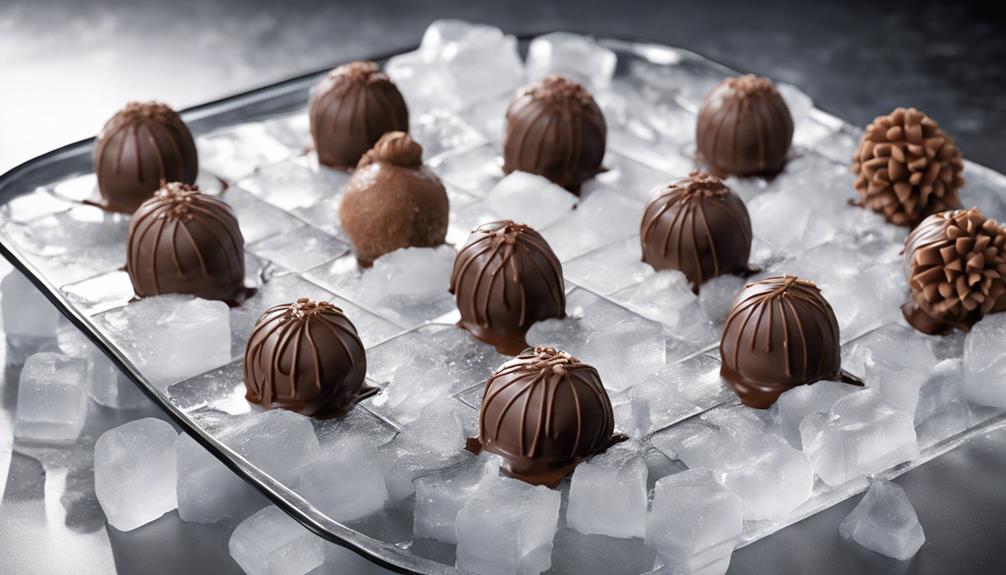
For a swift solution to guarantee chocolate from melting, consider employing quick chilling techniques. When you need to keep your chocolate cool in a pinch, these methods can be a lifesaver:
- Fridge Time: Pop your chocolate in the fridge for short bursts to preserve its shape and prevent it from turning into a gooey mess.
- Melt-Proof Options: Opt for melt-proof chocolate or candy melts that can withstand higher temperatures, ideal for transportation in warm weather.
- Cooler Packs: Seal your chocolate with cooler packs in insulated bags to create a cooling environment that will keep it from melting on the move.
- Freezer Fix: If a fridge isn't available, a temporary stay in the freezer can do wonders to prevent your chocolate from becoming a puddle.
These quick chilling techniques are simple yet effective ways to guarantee your chocolate stays intact and delicious, even when the heat is on.
Avoid Humid Environments
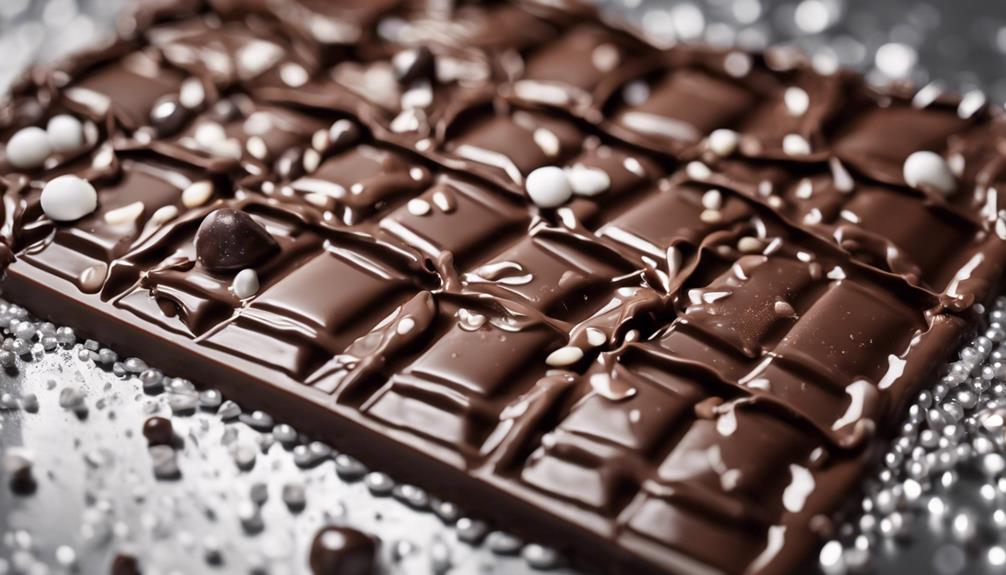
In keeping chocolate from melting, steering clear of humid environments is essential to preserving its texture and appearance.
Humid conditions can cause chocolate to absorb moisture, resulting in a grainy texture and a dull look. Excessive humidity may even lead to sugar bloom, where sugar crystallizes on the chocolate's surface, creating a gritty feel.
To prevent these issues, store your chocolate in a dry place and use airtight containers. High humidity can make chocolate sweat or develop condensation, altering its texture and taste.
To control humidity levels, consider using a dehumidifier or silica gel packs in the storage area. These measures will help protect your chocolate from melting or blooming, ensuring it stays delicious and visually appealing.
Transporting Chocolate Safely
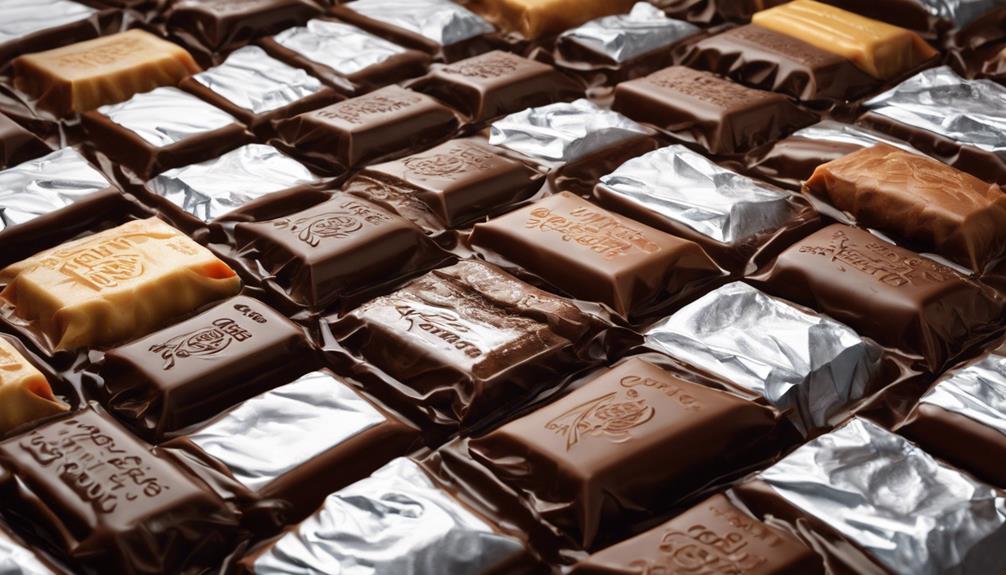
When transporting chocolate safely, it's important to guarantee its protection by sealing it with cooler packs in an insulated bag.
Remember to control the temperature and avoid exposing chocolate to heat sources like car interiors or direct sunlight.
Handling delicate treats with care during transport will help maintain their quality and prevent any melting mishaps.
Packaging for Protection
To guarantee chocolate remains intact while being transported, it's essential to utilize insulated bags with cooler packs for protection. When packaging chocolate for travel, consider these tips:
- Wrap chocolate in aluminum foil or parchment paper to insulate it from heat.
- Avoid leaving chocolate in a hot car to prevent melting.
- Seal chocolate in a plastic bag and place it over ice to keep it cool.
- Protect chocolate from water exposure by using airtight containers.
Temperature Control Tips
Maintaining proper temperature control is essential when transporting chocolate safely. Keeping couverture chocolate between 88-90 degrees Fahrenheit is vital for successful tempering. Dark chocolate typically sets within 2-3 minutes, while milk or white chocolate may take 3-5 minutes during this process. Avoid excessively stirring the chocolate while tempering to prevent crystallization, which can impact the final texture. When setting tempered chocolate, leave it uncovered to prevent blooming and achieve a smooth finish. A helpful tip is to test the tempering by spreading a small amount on paper or a knife to check for the correct setting time. This attention to temperature control and tempering techniques will help guarantee your chocolate arrives in perfect condition.
| Temperature Control Tips | |||
|---|---|---|---|
| Couverture Chocolate | 88-90°F | Proper Tempering | Essential |
Handling Fragile Treats
Handling fragile treats like transporting chocolate safely requires careful planning and specialized tools for maintaining ideal conditions. When it comes to transporting delicate chocolate treats, here are some essential tips to prevent your chocolate from melting and guarantee it arrives intact:
- Use melt-proof chocolate or candy melts designed for hot climates.
- Seal chocolate in an insulated bag with cooler packs to maintain a cool temperature.
- Avoid direct sunlight or heat sources during transportation.
- Opt for short-term freezer storage if refrigeration isn't available.
Prevent Overheating During Preparation

During the preparation process, it's important to take steps to prevent overheating when melting chocolate. To maintain the structure of the chocolate and avoid a grainy texture in your final product, it's essential to handle the melting process with care.
Start by chopping the chocolate into small, uniform pieces. This not only speeds up the melting process but also reduces the risk of overheating. When using the microwave, opt for a microwave-safe bowl and heat the chocolate in short intervals, stirring in between each session to prevent scorching.
Another helpful tip is to grate the chocolate before melting. By breaking it down into smaller pieces, you ensure quicker exposure to heat, facilitating a smoother melting process.
For a more controlled and even melt, consider using a double boiler or bain marie. This method provides indirect heat, helping melt the chocolate evenly and preventing overheating.
Frequently Asked Questions
How Do You Keep Chocolate From Melting Easily?
To keep chocolate from melting easily, I store it in a cool, dark spot around 50-66.2°F. I avoid extreme temperatures and never refrigerate it for long. If traveling to hot areas, I use melt-proof chocolate or cooler packs.
How Do I Make Sure My Chocolate Doesn't Melt?
I keep my chocolate from melting by storing it in a cool, dry spot away from heat and sunlight. I love savoring its rich flavors, so I always make sure to protect it.
What Do They Put in Chocolate to Stop It Melting?
I add cocoa butter, lecithin, and stabilizers like palm oil to chocolate to prevent melting. They help maintain its structure in warm conditions. These ingredients are essential for ensuring my chocolate stays solid and delicious.
How Do Companies Keep Chocolate From Melting?
To keep chocolate from melting, companies use insulated packaging, cool packs, and temperature-controlled vehicles. Advanced cooling systems in storage facilities maintain ideal temperatures. Quality control guarantees chocolate doesn't melt before reaching customers. Specially formulated chocolate with higher melting points is also used.
Can These Chocolate Melting Prevention Tips Also Apply to Raw Cold Food?
When it comes to preventing chocolate from melting, the same tips may not apply to raw cold food. However, it’s important to be aware of the symptoms of raw food eating, such as digestive discomfort and potential foodborne illness. Proper storage and handling are key for both chocolate and raw food to avoid any negative effects.
Conclusion
To sum up, by following these 10 tips, you can prevent your chocolate from melting and guarantee it stays in perfect condition. Remember to store it in a cool place, use high cocoa content chocolate, and avoid direct sunlight exposure.
Properly wrapping and storing your chocolate, as well as taking precautions during transportation and preparation, will help you enjoy your sweet treats without any melting woes. Keep your chocolate safe and enjoy every bite!
Rachael, the Editor in Chief of RachaelsRawFood.com, is an inspiring and passionate individual who has dedicated her life to promoting the benefits of a raw food lifestyle. Known for her vibrant and energetic personality, Rachael has built a strong online presence that has transformed her personal journey into a thriving community of raw food enthusiasts.
Raw Food Ingredients
How Much Caffeine in Cocoa?
Not all cocoa products are created equal when it comes to caffeine content – discover which one might surprise you!
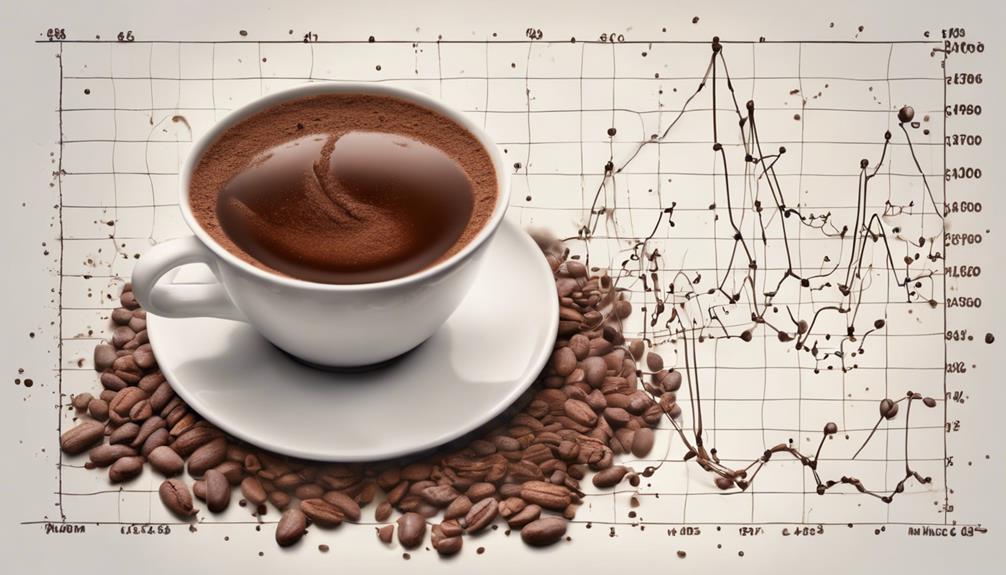
When evaluating the caffeine levels in cocoa, it’s important to recognize that dark chocolate contains around 43 mg of caffeine per 100 grams due to its high cocoa solid content. Dark chocolate has a higher caffeine content compared to milk or white chocolate. This means that consuming dark chocolate in moderation can assist in managing your caffeine intake. On the other hand, milk chocolate has around 20 mg of caffeine per 100 grams while white chocolate is caffeine-free. Cocoa powder, commonly used in baking and beverages, contains a substantial 230 mg of caffeine per 100 grams. Being aware of these distinctions in chocolates can help you make informed decisions about your caffeine consumption.
Key Takeaways
- Caffeine content in cocoa varies based on cocoa solid concentrations.
- Unsweetened cocoa powder can contain around 230 mg of caffeine per 100 grams.
- Roasting cocoa solids influences the final caffeine content in cocoa products.
- Dark chocolate, with high cocoa solid content, has more caffeine than milk chocolate.
- Moderate consumption of cocoa products helps manage caffeine intake.
Caffeine Content in Dark Chocolate
Dark chocolate boasts a caffeine content of approximately 43 mg per 100 grams, mainly deriving from its higher cocoa solid composition. When we indulge in this decadent treat, we aren't only savoring its rich cocoa flavor but also a subtle caffeine kick. Compared to milk or white chocolate, dark chocolate contains a higher amount of caffeine.
Please bear in mind that moderate consumption of dark chocolate can assist individuals in managing their caffeine intake effectively. The caffeine levels in dark chocolate are about one-fourth of what you'd find in a standard cup of coffee. So, if you're looking for a milder caffeine boost, a piece of dark chocolate might just do the trick without the jitters that sometimes accompany a strong cup of coffee.
Enjoy your dark chocolate in moderation, savoring both its taste and the gentle pick-me-up it provides.
Caffeine Levels in Milk Chocolate
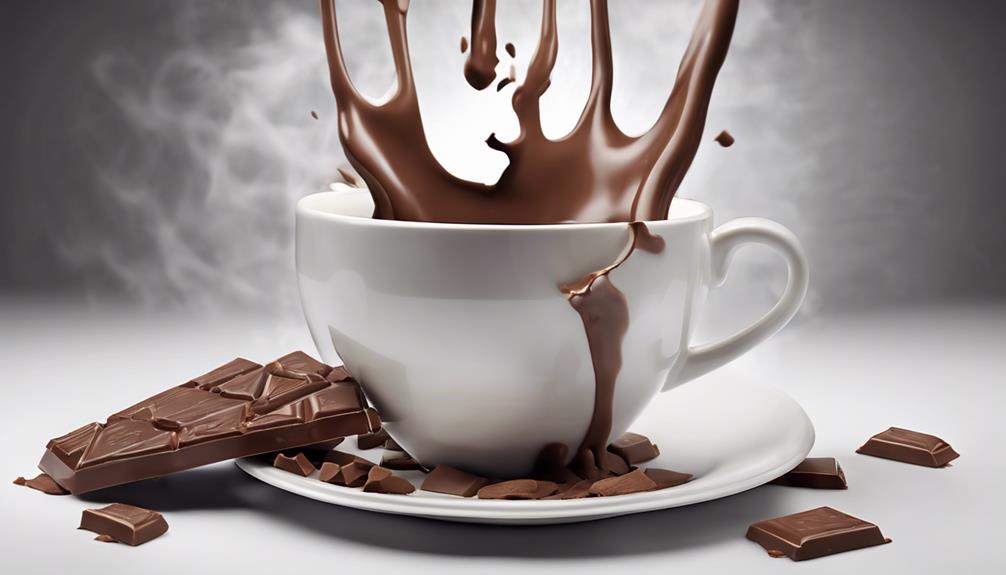
Milk chocolate, known for its creamy texture and sweet flavor, contains a modest caffeine content of approximately 5.6 mg per ounce, as indicated by USDA data. Unlike dark chocolate, milk chocolate has a lighter color due to lower cocoa content, resulting in reduced caffeine levels.
The delightful creamy taste in milk chocolate comes from a harmonious blend of cocoa and milk powder. While dark chocolate boasts higher caffeine content, milk chocolate remains a popular choice for those seeking a sweet treat with minimal caffeine intake.
Caffeine Presence in White Chocolate
With its unique composition excluding cocoa solids, white chocolate stands out as a caffeine-free alternative to its darker counterparts. White chocolate is crafted from a blend of cocoa butter, milk powder, sugar, and vanilla, making it a delectable treat without the stimulating effects of caffeine. For individuals sensitive to caffeine, white chocolate offers a creamy texture and indulgent flavor without the worry of unwanted side effects. This makes it a popular choice for desserts among those looking to steer clear of caffeine in their sweet treats.
Compared to dark chocolate, which contains cocoa solids and hence caffeine, white chocolate provides a caffeine-free option for those seeking a more mellow indulgence. So, if you're in the mood for a luscious and smooth chocolate experience without the buzz of caffeine, white chocolate is the perfect choice for your next dessert delight.
Impact of Cocoa Solids on Caffeine
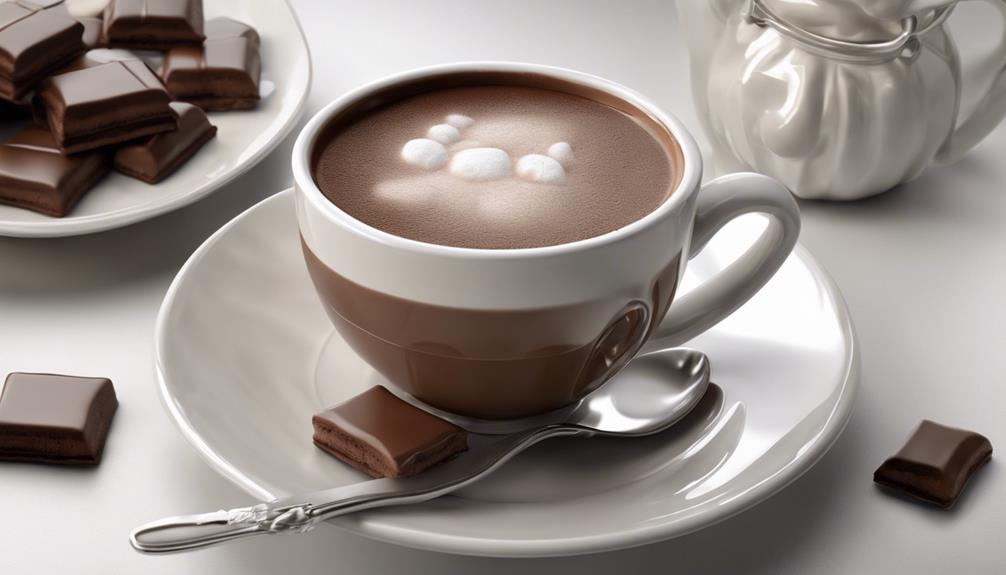
In determining the caffeine levels in cocoa products, the percentage of cocoa solids plays a significant role. Here are some key points about the impact of cocoa solids on caffeine content:
- Caffeine Derivation: The caffeine content in cocoa primarily comes from cocoa solids, making it an important factor in determining the overall caffeine levels in cocoa-based products.
- Dark Chocolate: Dark chocolate, known for its higher cocoa solid content, tends to contain more caffeine compared to milk or white chocolate varieties due to this higher concentration.
- Unsweetened Cocoa Powder: A 100g serving of unsweetened cocoa powder can contain around 230mg of caffeine, reflecting the impact of the high cocoa solid content in this form.
- Health Benefits: The roasting process of cocoa solids not only affects the flavor profile but also influences the caffeine content, contributing to the potential health benefits associated with consuming cocoa products like hot cocoa.
Comparing Caffeine in Different Chocolates
Comparing the caffeine content in different chocolates reveals varying levels based on their cocoa solid concentrations. Dark chocolate contains about 43 mg of caffeine per 100 grams, making it a stronger caffeinated option compared to milk chocolate, which only has around 20 mg per 100 grams.
Surprisingly, white chocolate, derived from cocoa butter, doesn't contain any caffeine at all. For those seeking a more potent caffeine kick, cocoa powder is the way to go, boasting a high concentration of 230 mg per 100 grams.
The amount of caffeine in chocolate products is closely linked to the cocoa solid content, with dark chocolate containing the highest levels. So, the next time you're craving a chocolate treat but also need a little energy boost, opt for dark chocolate to get the most caffeine per bite.
Frequently Asked Questions
Is There More Caffeine in Cocoa Than Coffee?
There's more caffeine in cocoa than in coffee. Cocoa powder packs 230 mg per 100 grams, surpassing most coffee varieties. Dark chocolate has even more caffeine due to higher cocoa content. It's a rich, unique energy source.
Is There a Lot of Caffeine in Hot Cocoa?
There isn't a lot of caffeine in hot cocoa. It depends on the brand and recipe. Starbucks hot chocolate has around 25 mg per serving, while basic mixes have about 5 mg. The amount of cocoa powder used influences the caffeine content.
Is There Caffeine in Hershey's Cocoa?
Absolutely, Hershey's Cocoa does contain caffeine, but it's not overwhelming. It adds a delightful hint of energy in each spoonful. Perfect for baking or a cozy cup of hot chocolate. Just the right amount!
Is Cocoa a Stimulant Like Caffeine?
Cocoa stimulates like caffeine due to its theobromine content. Decaf versions offer a solution for caffeine-sensitive folks. Options include regular cocoa with caffeine, Dutch-processed cocoa with less, and decaf cocoa with reduced caffeine while keeping healthful compounds.
What are the potential health effects of consuming high levels of caffeine in cocoa?
Unveiling cocoa caffeine levels can lead to potential health effects of excessive consumption. High levels of caffeine in cocoa may contribute to insomnia, nervousness, and fast heartbeat. It can also cause gastrointestinal discomfort and exacerbate anxiety disorders. Moderation in consuming caffeinated cocoa products is recommended for overall health.
Conclusion
To sum up, the caffeine content in cocoa varies depending on the type of chocolate. Dark chocolate typically has the highest caffeine levels, followed by milk chocolate and white chocolate. The amount of cocoa solids in the chocolate also affects the caffeine content.
Remember, just like different chocolates have different levels of caffeine, we all have unique strengths and abilities. Embrace your individuality and always aim for balance in everything you do.
Rachael, the Editor in Chief of RachaelsRawFood.com, is an inspiring and passionate individual who has dedicated her life to promoting the benefits of a raw food lifestyle. Known for her vibrant and energetic personality, Rachael has built a strong online presence that has transformed her personal journey into a thriving community of raw food enthusiasts.
Raw Food Ingredients
5 Key Differences: Caffeine Content in Cocoa Vs Coffee
Open the door to understanding the contrasting caffeine levels in cocoa and coffee, revealing surprising insights that will reshape your beverage choices.
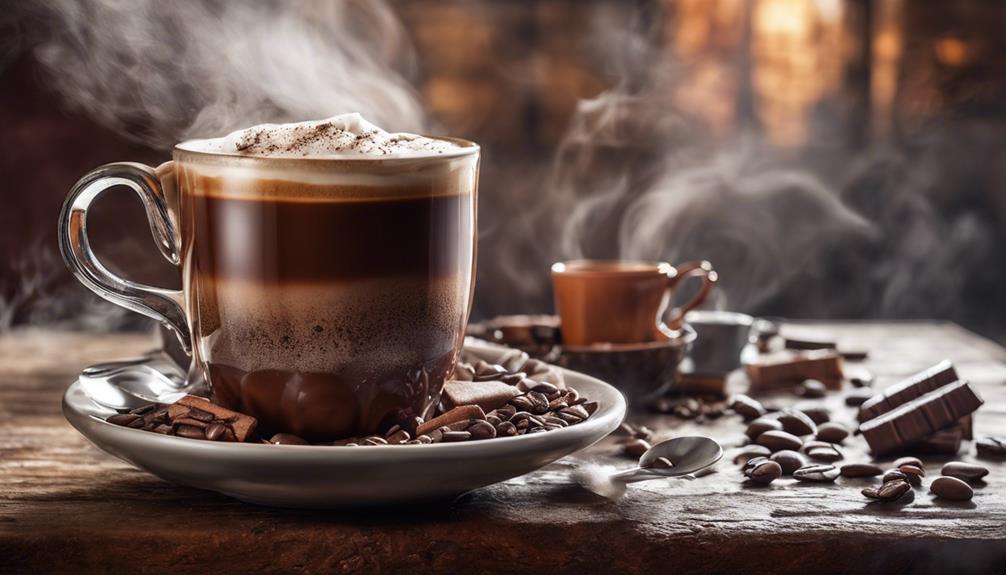
When comparing the caffeine levels in cocoa and coffee, it is important to understand that cocoa generally has lower caffeine content than coffee. Dark chocolate contains approximately 12 milligrams of caffeine per ounce, while hot cocoa typically ranges from 5 to 10 milligrams per ounce. In contrast, brewed coffee can have significantly higher levels, varying from 95 to 165 milligrams per 8-ounce cup.
Cocoa is considered a milder option for individuals aiming to limit their caffeine intake, with theobromine providing a gradual energy increase. Meanwhile, coffee's caffeine content offers immediate alertness, and understanding these distinctions can help you select based on your preferred effects.
Key Takeaways
- Cocoa contains lower caffeine levels but compensates with theobromine for a gradual energy increase.
- Coffee has higher caffeine content, offering an immediate alertness boost and potentially higher metabolic rate.
- Theobromine in cocoa promotes relaxation, while caffeine in coffee provides intense alertness and mood fluctuations.
- Hot chocolate is a good option for reducing caffeine intake while still benefiting from theobromine effects.
- Understanding caffeine variances helps make informed choices for desired energy levels and mood effects.
Caffeine Levels in Cocoa Vs Coffee
When comparing caffeine levels in cocoa versus coffee, it's evident that cocoa generally contains lower amounts per serving. Dark chocolate, made from cacao beans, contains around 12 milligrams of caffeine per ounce, while a 1-ounce serving of hot cocoa mix typically has 5-10 milligrams. Even a 16-ounce serving of Starbucks hot chocolate only contains about 25 milligrams of caffeine.
On the other hand, coffee, when brewed, can range from 95 to 165 milligrams of caffeine per 8-ounce cup, depending on the type and brewing method. This significant difference in caffeine content between cocoa and coffee makes cocoa a milder option for those looking to limit their caffeine intake.
Impact on Alertness and Energy
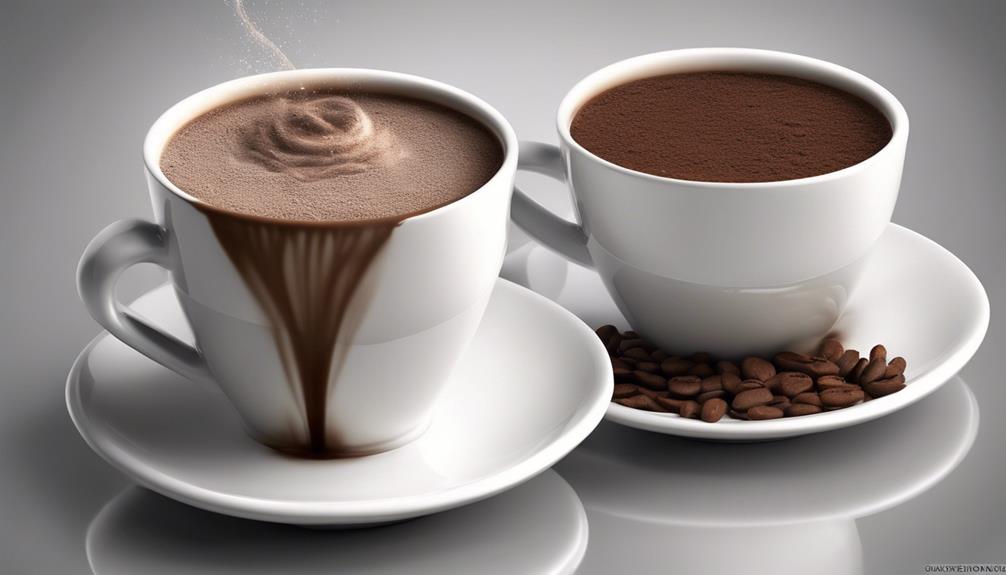
Typically, the immediate alertness and energy boost from caffeine in coffee can last for hours. This surge in alertness is due to caffeine's stimulating effect on the central nervous system. On the other hand, cocoa contains theobromine, which provides a more gradual increase in energy levels. Unlike caffeine, theobromine doesn't cause sudden spikes and crashes, offering a smoother energy curve.
Coffee's caffeine content can temporarily boost the metabolic rate, potentially supporting weight management efforts. This increased metabolic rate can aid in burning calories and may contribute to weight loss when combined with a balanced diet and regular exercise. Additionally, theobromine in cocoa contributes to the thermogenic effect, leading to mild calorie burning in the body.
Both caffeine and theobromine can influence mood. Caffeine tends to provide a more intense and quick-acting mood elevation, while theobromine promotes feelings of relaxation and contentment. Understanding the differences in alertness, energy, metabolic effects, and mood enhancements between cocoa and coffee can help individuals make informed choices based on their preferences and wellness goals.
Metabolic Variances and Effects
Regarding metabolic variances and effects, the varying caffeine levels between cocoa and coffee play a significant role. When comparing the metabolic impact of caffeine in cocoa and coffee, it is crucial to note that cocoa contains lower levels of caffeine but compensates with theobromine, which aids in the thermogenic effect, promoting calorie burning and metabolic activity. On the other hand, coffee, especially brewed varieties, contains higher levels of caffeine, potentially providing a temporary boost to the metabolic rate, which could assist in weight management. While caffeine in coffee offers a quick energy surge, theobromine in cocoa leads to a more gradual rise in energy levels, avoiding sudden spikes and crashes. To summarize the metabolic differences, I've created a table below:
| Aspect | Cocoa | Coffee |
|---|---|---|
| Caffeine Content | Lower levels | Higher levels |
| Additional Component | Theobromine | Caffeine |
| Metabolic Impact | Thermogenic effect | Temporary metabolic rate boost |
| Energy Levels | Gradual rise | Quick surge |
| Weight Management | Aids in calorie burning | Potential assistance |
Mood Enhancement Disparities

In comparing the mood enhancement effects of theobromine in cocoa and caffeine in coffee, notable disparities emerge in their impact on mental well-being.
The theobromine found in cocoa promotes relaxation and contentment, offering a gradual rise in energy levels that leads to a gentle and long-lasting mood enhancement experience.
On the other hand, caffeine delivers an intense and fast-acting boost in alertness, providing immediate energy levels that can lead to abrupt spikes and crashes.
While both theobromine and caffeine uplift mood, theobromine's effects are characterized by a steady and gradual increase in energy levels, creating a sense of calm and contentment.
In contrast, caffeine's impact is more intense and temporary, resulting in rapid alertness but also the potential for fluctuations in mood. Understanding these differences can help individuals choose between cocoa and coffee based on their desired mood enhancement effects.
Health Implications and Considerations
Health implications and considerations surrounding caffeine consumption warrant close attention due to its potential impact on various aspects of well-being. When comparing a cup of coffee to hot chocolate, it's vital to note the amount of caffeine present.
While coffee contains much caffeine, hot chocolate has less caffeine but isn't entirely devoid of it. The main active ingredients in hot chocolate are theobromine and caffeine, where theobromine is a relative of caffeine and also has stimulant effects, although milder. If you're looking to reduce your caffeine intake, opting for hot chocolate over a cup of coffee can be a good choice.
Being mindful of the caffeine content in chocolate products is important, especially if you're sensitive to caffeine or belong to vulnerable populations like children or pregnant women. Understanding the caffeine levels in different beverages allows you to make informed decisions about your consumption for better overall health.
Frequently Asked Questions
Is There Caffeine in Coffee Vs Cacao Powder?
Yes, there is caffeine in coffee, with around 140 milligrams in a 12-ounce cup. On the other hand, cacao powder contains only about 12 milligrams per tablespoon, making it a great caffeine-free alternative for those seeking a milder boost.
What Is the Difference Between Cocoa and Coffee?
When comparing cocoa and coffee, cocoa offers a rich, chocolatey flavor and is packed with antioxidants and minerals. Coffee, on the other hand, provides a robust, bitter taste and a jolt of caffeine for that morning pick-me-up.
Why Is Cocoa Better Than Coffee?
I believe cocoa is superior to coffee because it offers a gentler energy boost, promotes relaxation and contentment, and provides sustained vitality without sudden crashes. Plus, dark chocolate's theobromine supports cellular health and tastes delicious.
How Much Caffeine Is in Cocoa Powder Vs Decaf Coffee?
In cocoa powder vs decaf coffee, cocoa has 12-26mg of caffeine per tbsp, while decaf coffee holds 2-5mg per 8-ounce cup. The choice hinges on desired caffeine levels and flavor. I prefer cocoa's lower caffeine content.
How does the caffeine content in hot chocolate compare to coffee?
Hot chocolate caffeine content is significantly lower than that of coffee. While an 8-ounce cup of hot chocolate contains about 5-10 milligrams of caffeine, the same size of coffee can have anywhere from 95-200 milligrams. It’s a notable difference for those looking to limit their caffeine intake.
Conclusion
To sum up, while cocoa and coffee both contain caffeine, the levels vary significantly. Cocoa generally has lower caffeine content compared to coffee, impacting alertness, energy levels, and mood enhancement differently.
It's crucial to keep these differences in mind when choosing between the two beverages for your daily consumption. Remember, moderation is key to maintaining a healthy balance in your caffeine intake.
So, whether you prefer a cup of cocoa or a mug of coffee, enjoy it in moderation for the best benefits!
Rachael, the Editor in Chief of RachaelsRawFood.com, is an inspiring and passionate individual who has dedicated her life to promoting the benefits of a raw food lifestyle. Known for her vibrant and energetic personality, Rachael has built a strong online presence that has transformed her personal journey into a thriving community of raw food enthusiasts.
Raw Food Ingredients
A Guide to Becoming a Good King
Kingship demands wisdom, fairness, integrity, courage, and humility – essential traits for a successful reign and prosperous kingdom." Keep reading to uncover the secrets of becoming a good king.

In order to be a good king, one must embody wisdom, fairness, integrity, courage, and humility to lead the kingdom with honor. Wisdom is essential for making important decisions, fairness ensures just treatment for all, integrity builds trust and respect, courage is crucial for facing challenges, and humility reminds us of our humanity. Historical kings such as Solomon, Arthur, David, Charlemagne, and Ramses II serve as role models for these leadership traits.
As a king, embracing challenges, understanding the world, seeking personal growth, and learning from the past are essential responsibilities. Developing leadership skills, making wise decisions, and prioritizing the well-being of the people are key to effective kingship. Every step on the path to becoming a good king is critical for a successful reign and prosperous kingdom.
Key Takeaways
- Embrace wisdom for informed decisions.
- Practice fairness for just treatment.
- Uphold integrity to earn trust.
- Show courage in facing challenges.
- Maintain humility for empathy and respect.
Qualities of a Good King
Being a good king requires embodying qualities such as wisdom, fairness, integrity, courage, humility, and compassion in decision-making and leadership. Power comes with responsibility, and as a king, it's essential to wield this power wisely. Wisdom is vital in making sound judgments that benefit the kingdom as a whole. Fairness guarantees that all subjects are treated justly and equitably, fostering a harmonious society. Integrity is the foundation of trust and respect, key elements in effective leadership.
Courage is necessary to face challenges and make difficult decisions, even when met with opposition. Humility reminds a king of his humanity and the importance of humility in interactions with all subjects. Compassion demonstrates a king's care and empathy towards his people, fostering a sense of unity and loyalty. Effective communication is crucial for conveying decisions, listening to concerns, and inspiring confidence in leadership.
Historical Kings as Role Models

King Solomon, renowned for his wisdom and leadership, stands as an exemplar among historical kings who serve as role models for future leaders. Looking at figures like King Arthur, known for his justice and valor in medieval legends, and King David, celebrated for his faith and courage in battle, we find lessons that transcend time. Charlemagne's legacy of military conquests and cultural revival, alongside Ramses II's grand building projects and military campaigns, offer diverse insights into effective kingship. Below is a table summarizing key attributes of these historical kings:
| King | Attributes |
|---|---|
| King Solomon | Wisdom, leadership |
| King Arthur | Justice, valor |
| King David | Faith, courage |
| Charlemagne | Military prowess, culture revival |
| Ramses II | Building projects, military campaigns |
Studying these historical figures can provide valuable lessons on the multifaceted qualities that make a great ruler.
Responsibilities of Kingship
Embracing challenges and living authentically are central to fulfilling the responsibilities inherent in kingship. As men aspiring to be good kings, it's essential for us to understand that the world requires leaders who are kind, humble, and committed to personal growth.
The journey to becoming a good king involves more than just wielding power and responsibility—it entails sacrificing comfort for growth and transformation. Seeking the ancient path of masculinity, as exemplified by figures like Morgan, teaches us the importance of humility, vulnerability, and character development.
In fulfilling the responsibilities of kingship, we're entrusted with power not for our own gain, but for the betterment of the world around us. Just as seeds need Good Soil to flourish, we must nurture our own growth to lead effectively.
Leadership Skills for Kings

Developing essential leadership skills is crucial for aspiring kings seeking to fulfill their responsibilities with humility, vulnerability, and a focus on character development. As you study the world around us, the power and responsibility of what kingship entails become clearer. Here are some key points to think about on your path to becoming a king:
- Embrace challenges and live authentically.
- Seek ancient paths of masculinity for guidance.
- Reflect on your identity, purpose, and ability to be entrusted with power for good.
- Sacrifice comfort for growth, transformation, and participation in universal creativity.
The journey of becoming a king isn't just about gaining authority but about understanding the remarkable fellowship of like-hearted individuals who share similar goals. Engage in group discussion questions, consider between-session personal study, and explore the depths of your masculine soul. This is the path to restoring what it means to be a true king.
Importance of Wise Decision-Making
Steering through the intricacies of leadership, especially in the domain of kingship, requires a sharp focus on the art of prudent decision-making. Wise decision-making is like the compass guiding the ship of leadership towards success.
Good kings understand that their choices impact not just themselves but also the lives of those they rule over. They prioritize the well-being of their people over personal gains, embodying the essence of true leadership.
Seeking counsel from trusted advisors and reflecting on core values are essential practices in the domain of wise decision-making. By embracing humility and self-awareness, kings can navigate the complex web of choices with clarity and integrity.
Just like a six-session video Bible study can guide individuals in restoring the heart, wise decision-making is essential for becoming the kind of leaders our world needs. Let's start on this journey of radical reconstruction, where every decision is a step towards being counted among the good kings of history.
Frequently Asked Questions
What Is the Becoming a King Guide?
The Becoming a King guide is a transformative resource created by Morgan Snyder to help men grow into responsible kings. It offers practical tools and profound insights to aid personal development and transformation.
What Are the Qualities of a Good King?
Being a good king means embodying humility, wisdom, and integrity. Prioritizing the well-being of my people, making decisions for the greater good, and showing courage, justice, and compassion in all actions. Seeking counsel and valuing diverse perspectives is essential.
What Makes a True King?
Beneath the crown lies a heart that beats with humility and a spirit that soars with honor. True kings are forged in the fires of challenge, embracing authenticity and growth to inspire others.
What Makes a Real King?
Being a true king means embodying humility, courage, and empathy. It's about serving others and leading with integrity. I endeavor to cultivate these qualities daily, embracing challenges and seeking growth in all aspects of my life.
How Can Sacred Cacao be Incorporated Into Kingship Rituals?
In kingship rituals, the sacred cacao ritual holds great significance. The ceremonial drinking of cacao symbolizes the divine connection between the ruler and the spiritual realm. It is believed to impart wisdom and strength, making it a crucial element in the coronation and leadership rites of many cultures.
Conclusion
To sum up, becoming a good king requires a combination of qualities, skills, and responsibilities. Remember, 'With great power comes great responsibility.'
By studying historical kings as role models, practicing leadership skills, and making wise decisions, one can aspire to be a just and effective ruler.
It's a challenging path, but with dedication and perseverance, anyone can endeavor to be a worthy leader for their kingdom.
Rachael, the Editor in Chief of RachaelsRawFood.com, is an inspiring and passionate individual who has dedicated her life to promoting the benefits of a raw food lifestyle. Known for her vibrant and energetic personality, Rachael has built a strong online presence that has transformed her personal journey into a thriving community of raw food enthusiasts.
-

 Health and Wellness2 months ago
Health and Wellness2 months agoDoes Eating Raw Food Help You Lose Weight? Discover the Truth
-

 Raw Food Recipes2 months ago
Raw Food Recipes2 months agoHow Much Raw Food to Feed Your Puppy: Essential Tips
-

 Kitchen Essentials for Raw Food Preparation1 month ago
Kitchen Essentials for Raw Food Preparation1 month agoCan You Cook Raw Food in an Air Fryer? Discover the Possibilities
-

 Raw Food Recipes2 months ago
Raw Food Recipes2 months agoHow to Defrost Dog Raw Food Properly
-

 Health and Wellness2 months ago
Health and Wellness2 months agoHow Long Does It Take Bacteria to Spread From Raw Food? Essential Info
-
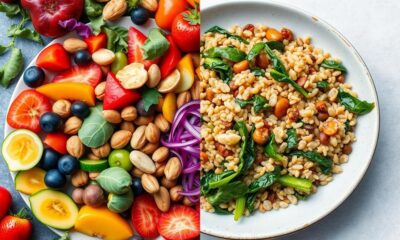
 Raw Food Recipes2 months ago
Raw Food Recipes2 months agoRaw Food Vs. Vegan: Which Diet Is Better?
-

 Raw Food Recipes2 months ago
Raw Food Recipes2 months agoIs Raw Food Good for Cats? Find Out Here
-

 Raw Food Recipes2 months ago
Raw Food Recipes2 months agoWhat Is the Raw Food Diet? A Comprehensive Overview
